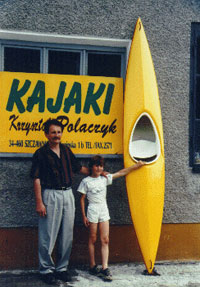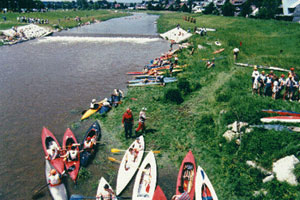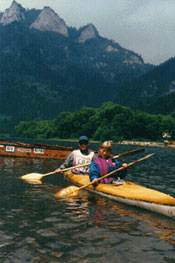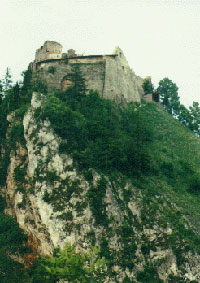 |
|
|
Down The Dunajec: The Oldest Kayak Rally In Europe
Text and photos by Robert
Huszar
|
I half expected to hear a calliope
as we walked down the midway. There were tents to the
horizon, filling the local churchyard and spilling over
into neighboring fields. The earth was fragrant with
honeysuckle, alfalfa and fresh river mud; the air was
rich with the scent of grilling meats. Barkers hawked
T-shirts and pennants and toys for the kids. Vendors
sold everything from food to hair-care products. Kayaks
and canoes were scattered everywhere.
|
 Father-daughter kayak
team
Father-daughter kayak
team |
|
|
Lisa and Denise were hungry and we
stopped for a kielbasa. They cost 2 zloty apiece,
about 86 cents American, and were served on a paper plate
with a slab of rye bread on the side. We munched as we walked.
It was hard to believe that a kayaking event could generate
such festive enthusiasm. Back in the States, kayaking is still
relatively low key -- really only gaining mass appeal in the
last ten years -- whereas in Europe it's been popular for
almost a century. Today's event, Poland's 54th Annual International
Rally on the Dunajec River, is actually 75 years old, but
was interrupted multiple times by two world wars and countless
years of foreign occupation.
The rally -- basically a 3-day party
over 57 miles of river -- is organized in three tiers: with
competitors, paddlers, and tourists coming from all over Europe.
In the competitions, rivals match speed
and slalom runs and are categorized by age (above and below
35), by sex, boat type (single kayak, double kayak and canoe),
and "mixed," meaning any combination of anything.
The byword for this competition is "very friendly,"
and mixing allows grandparents to paddle with grandchildren,
or their Olympic-trained son-in-laws, in big heavy canoes
or light and agile river boats.
In the paddler class, there are no
categories. The river's described as Class 2-3, but if anything
it's more a good-time float trip, with its one danger being
capsized while gawking at the Dracula-like landscape of craggy
castles and Carpathian Mountain gorges. The drops are all
non-technical, with the few obstacles (such as a low-head
dam) being either runnable or easily portaged. Most people
were paddling old, multiply-patched fiberglass boats that
looked as old as the river itself; many of the paddlers were
not even using whitewater boats, but 40- to 50-year-old canvas
and rubber folding sea kayaks. What a treat that was for me!
My first boat was a Rugged Klepper Folding Kayak -- and here
I was, seeing great-grandfathers’ Kleppers, along with
boats by Pouch, Granta, Neptune and Jantar.
In the tourist class, you ride on large
wooden rafts through the Dunajec Gorge, sitting on wide church-like
benches, piloted by two ethnically garbed oarsmen.
|
|

Paddlers
begin to cue up for the start
of the rally in the village of Nowry Targ
|
We five Americans were not competing,
but paddling as representatives of the U.S. boating
community and as journalists. Jib Ellison is the head
of Project Raft, which had organized many multi-national,
cooperative paddling ventures in Russia, Costa Rica
and Chile. Eugene Buchanan is the editor-in-chief and
head writer for Paddler magazine; his wife Denise
is a photographer for the same publication.
|
|
|
|
Lisa Alpine is a nationally known travel
writer, a creative director for Specialty Traveler Index and
a whitewater guide in northern California. And I was there
as a journalist and as the founder of the Hudson River Waterway
Association, a group building a 150-mile-long paddling trail
in New York State.
Yurek Majcherczyk, a kayaker who was
internationally known for many first descents in South America,
had organized the trip because he wanted the boating community
in the U.S. to know what a wealth his native Poland offered
in paddling opportunities. "There are 9,000 lakes and
over 1,000 rivers in this country. Poland has more lakes then
any country in Europe, except Finland," Yurek pointed
out, "and many are interconnected and just perfect for
week-long sea kayak/canoe tours, or Class 2 to 5 whitewater
adventures. But, thanks to years of Communist occupation,
no one thinks of Poland as a vacation spot, even though we
have some of the most spectacular waterways in the world and
some of the cheapest prices in all of Europe."
|
|
As we were about to launch, Yurik explained
the daily log-in procedure, which consisted of paddling past
the judge and yelling piec . . . osiem . . . dwa, which
in my case meant paddler "582." I picked up my faded
white fiberglass kayak, tossed it on my shoulder, hauled it
up and over the small bank and proudly paddled across to the
eddy on the other side.
Halfway across I realized my phrase
had escaped me. I tried to reconstruct it with the primer
Yurek gave us on the plane ride over, but the extra "Zs"
and "Ws" of the Polish tongue were spinning frantically
in my head. My God, I thought, my first occasion as a diplomat
and I've already forgotten my lines. I mouthed some incomprehensible
syllables and broke out laughing, the judge looking equally
befuddled. I flashed the biggest rogue grin I could muster
and hand-signaled the individual numbers. The judge smiled
and nodded, looking relieved, and waved me on.
|

| Eugene Buchanan and
wife Denise with the Three Crowns of the Dunajec Gorge
in the background. |
|
|
What we didn't know at the time was
that 950 people had reserved for the rally (the rally topped
out at 2400 in 1984), but because of a forecast of unstable
weather patterns only 700 actually participated. What was
also unknown to us was that in the mountains of Southern Poland,
unstable meant daily thunder showers, torrential but lasting
only 10 to 30 minutes.
So, not knowing the pattern, when that
first storm hit we quickly found a place to pull over. As
we were donning our rain gear, a group of flimsy, bathtub-like
rafts filled with drunken men wearing only swim trunks, waving
vodka bottles and singing Polish drinking songs, floated by
in the deluge. At first I though we looked silly in our multi-colored
nylon outfits and our sunglasses dangling by chords from our
necks, till I noticed that these men also had their safety
cords dangling from their neck -- except that their safety
cords each held a shot glass, for vodka toasting. "Nastrovia,"
one of the men laughed, toasting as they passed. And the joke
was on us, for not more then ten minutes later the sun was
so bright that we were sweltering and had to pull over again
to remove our extra layers.
By the end of the day, as so often
happens with groups, we all began paddling at our own individual
speeds, and consequently separated. Lisa and I were paddling
together -- leisurely riding the swift current through a short
section of marshy wetlands -- when we rounded a bend in the
river and everything changed. The rolling, grassy hills that
had been our companions most of the day had suddenly grown
bigger, with great seams of granite outcropping pushing their
gray faces through the green facades. We had entered the foothills
of the Pipeny Mountains, part of the huge Carpathian range.
|
Poland's dramatic southern area is
delineated by two major ranges: the Sudeten and the Carpathian
Mountains. The Sudeten mountains form part of the border
with the Czech Republic, while the Carpathians actually
cut right through south-central Europe in a 900-square-mile
crescent shape that encompasses areas such as the Transylvanian
Alps; the Iron Gate (which is the gorge cut by the Danube
River on its way to the Black Sea); the Pass of the Tartars
in the western Ukraine; and the Hungarian lowlands. The
Carpathian elevation averages between 3,000 and 5,000 feet,
with a few peaks topping out at 8,000. But by far its most
unusual features are the small salt lakes that adorn some
summits and are locally referred to as "Eyes of the
Sea."
|

|
Castle
Czorstyn was built in the 1400s as a border outpost
and was the take-out spot for Day 1.
|
|
|
"Be on the lookout for the Castle
of Nidzica," Yurek had told us. "That's our take-out.
But be careful -- there are two castles. Don't go to the wrong
one."
Don't go to the wrong castle? I laughed
to myself. That's never been a problem in Pennsylvania.
At the take-out, we noted another difference
in Polish kayaking: a traveling kitchen was ladling out huge
portions of soups, stews, and cabbage dishes to hungry paddlers.
Sure beat my usual afternoon PowerBar, I thought as I wolfed
down a plate of bigos, a popular dish of cabbage and
meat, while staring at the castle looming surrealistically
on the horizon.
back
to top
|
|
|
|
Text and photos copyright ©1998
by Robert Huszar, 212-557-4949, ext. 206.
huszar@recteck.com
All rights reserved.
|
|